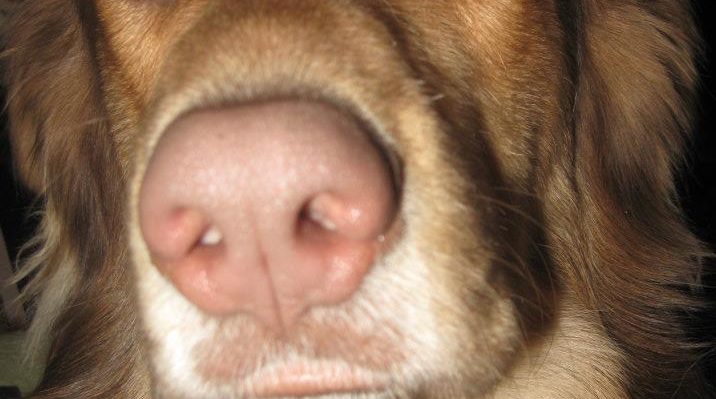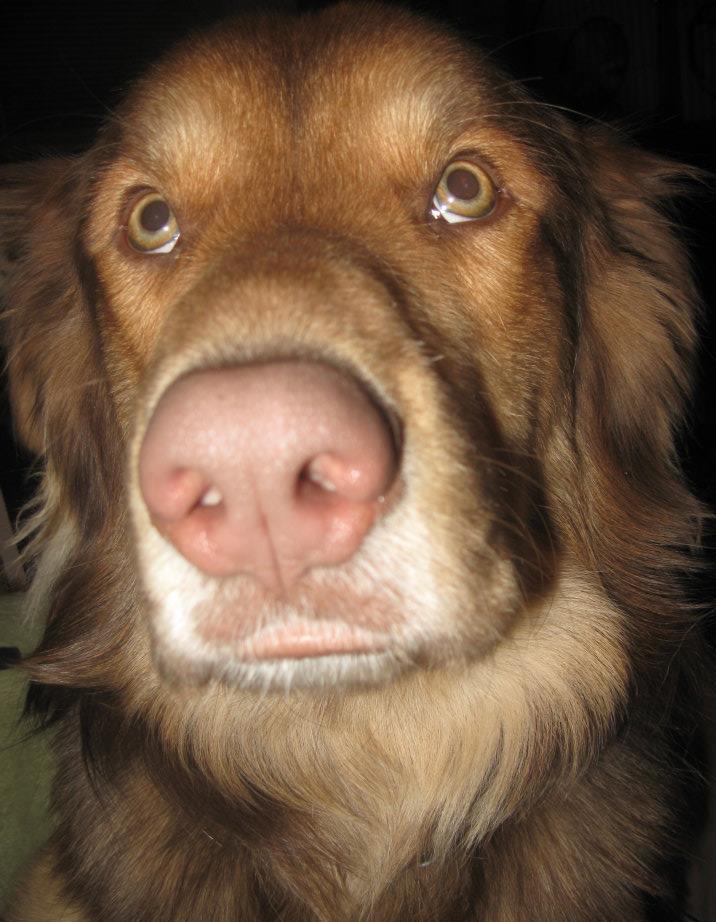
Pandemic pounds. Humans across the globe complain about the weight they gained during their year of stay-at-home. We have the opposite at my house. I lost a pants size; my dog looked as if he’d swallowed a barrel.
How did it happen?
It was all my fault!
It started, of course, with the stay-at-home: We did.
I shopped once every two weeks, uninterested in food. I had no enthusiasm for eating. That has never happened to my dog. He’s always been enthusiastic about eating, willing to try anything, including cigarette butts on the street. He was a stray, what can I say?
The weeks went on, becoming months.

Photo by Val Hughes
My staples became cereal and coffee, along with pasta-based microwaveable meals like mac and cheese, then later clam linguini from Trader Joe’s, which I ate for dinner several times a week. (I doubt I’ll eat it again, though; I reached capacity on that meal eventually.)
I did not share my meals with my dog—although, if it came in a microwaveable tray, the dog got to lick the tray clean for recycling . . . more and more with “a little” of the meal left for him, to be “generous.”
Why did I do that, let him lick containers?
I always had done that, with him and with most of my dogs in the past 40 years, when what was left in the tray would not be unhealthy for the animal. It seemed practical (no need to wash containers before they were recycled) and “normal” to me. It was a long-held habit.
Our older dog, quite elderly, could no longer tolerate foods except for her regular kibble (soaked to softness). I’d learned that lesson when I’d given her a few small bites—she was tiny—from a fast-food taco meal with nacho cheese. She’d had the runs for days.
I made a new rule: kibble only for the elder dog. No chances would be taken; it was too hard on her digestive system. I stuck to that rule. I could hardly feel good about making her sick.
I think that new “rule” for the older dog made giving the younger, fully healthy dog “bites” of human food easier for me. I would never “share” with him when the older dog was present. Sure, she was deaf and blind but, yes, she could smell what was passing by her small nose. Sharing with him and not with her, but in front of her, seemed decidedly unfair and unkind. I wouldn’t do that.
As time went by, sharing with my big dog became a ritual that brought us closer during those months when neither of us saw many other dogs, or humans either.
I found a few human snack foods that my younger dog and I could enjoy together:
▪ Goldfish crackers
▪ Ruffles potato chips
▪ Chex Mix Sweet ’n Salty
▪ Trader Joe’s Honey O’s cereal
▪ Trader Joe’s traditional meatloaf
True, none of these foods were good for him or that good for me. I was eating less “regular” food. He was eating his normal meals plus the snacks I shared. It took most of that pandemic year for the results to become visible. My pants bagged a bit; that’s all I noticed. I did not realize that, under his coat of heavy fur, his bones could not be seen or felt easily. He lost his waistline.
No longer did his fur lie flat on his sides and back. One day, I realized it: He looked as if he had swallowed a barrel. His fur was sticking out straight from his skin.
I couldn’t believe how his weight gain had snuck up on me!
I felt like an idiot.
I had never had a fat dog before.
I knew it was time for him to diet.
During the pandemic, dropping in at our veterinary clinic for a quick run into their lobby to weigh him on their scales was not the easy option it always had been. That he was overweight was obvious, but I didn’t know how much.
In the spring, I scheduled him for a yearly examination and a re-up for his rabies vaccination. I asked specifically about his weight.
I got a stern prescription from our veterinarian: My dog should lose 10 pounds. Ten pounds?!? He weighed 60, my fat dog, when his weight had averaged 53 pounds during the decade that he’d lived here.
I’d been satisfied with the food I’d been feeding for years, but our veterinarian was concerned it might not be giving my dog enough of the nutrition he needed if I reduced the amount I fed him daily. I took my vet’s suggestion and ordered a new food.
My dog was scheduled for dental surgery six weeks later. When he was weighed at that time, he’d already lost about three pounds. I was so happy!
He hasn’t been weighed since, but I can see and feel that he’s still losing. His fur lies down normally now and, under the fur, I can feel his bones through much less padding. When he’s wet after running through the sprinkler, I can see a waistline—not as slender as it was, but it’s there. He’s losing.
While I’d probably be okay with my dog’s returning to his “average” weight—the 53+ pounds he carried most of his life here—our veterinarian also pointed out that less weight meant less pressure on his hips. Extra weight is never friendly to a dog’s hips as he ages, and my dog is about a decade old now.
Will my dog stick with his diet until he weighs 50 pounds?
Keep in mind, it was never his intention to gain weight. It was not his choice. He did not do it on his own. I did it to him. It was my fault and I’m extremely sorry. I won’t let it happen again! I was doing him no favors. I was doing him no good. I may have made myself feel better, “bonding” with him over shared food that was not healthy for him. Enough of that!
My dog deserves a better human.
I’ll do my best to be the human he deserves.
Here are some suggestions for humans with dogs that need to diet.
Cut the treats.
▪ Cut treats from your dog’s diet—literally.
▪ Cut up or break treats into much smaller pieces.
▪ Cut the number of treats given daily. Keep track.
▪ Cut unhealthy treats completely. Use what’s in the dog’s regular diet instead.
Slow the eating.
▪ Soak the kibble first (safely in the fridge).
▪ Add water to make the kibble into soup.
▪ Use a slow feeder.
▪ Feed one bite at a time.
Enrich the eating.
▪ Use a food puzzle.
▪ Add healthy extras (like green beans, pumpkin).
Manage begging behaviors.
▪ Crate the dog out of sight while you’re eating.
▪ Do not reward begging for food . . . ever.
Evaluate what you’re feeding.
▪ Read nutrition labels and research.
▪ Ask your veterinarian for suggestions.
▪ Feed the right food for your dog.
▪ Feed the right amount for your dog.
Consult your veterinarian to construct a safe and healthy weight-loss program for your dog. Stick with the program, even if it seems to be taking too long. You can’t turn around weight gain overnight. It takes time and patience.
Recognize the small increments of improvement and don’t beat yourself up if you slip occasionally. Your dog is more likely to be encouraged by your good attitude than by your discouraged grumpiness. Be patient, be positive.
Hang in there—your dog deserves the best!



